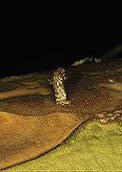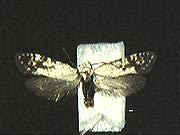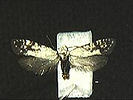Prodoxus
The bogus yucca moths
Olle Pellmyr


This tree diagram shows the relationships between several groups of organisms.
The root of the current tree connects the organisms featured in this tree to their containing group and the rest of the Tree of Life. The basal branching point in the tree represents the ancestor of the other groups in the tree. This ancestor diversified over time into several descendent subgroups, which are represented as internal nodes and terminal taxa to the right.

You can click on the root to travel down the Tree of Life all the way to the root of all Life, and you can click on the names of descendent subgroups to travel up the Tree of Life all the way to individual species.
For more information on ToL tree formatting, please see Interpreting the Tree or Classification. To learn more about phylogenetic trees, please visit our Phylogenetic Biology pages.
close boxConsensus based on Davis (1967) and Frack (1982)
Introduction
Prodoxus - the "bogus yucca moths" of Riley - are small to medium-sized moths that coexist on yuccas with the pollinating yucca moths, Tegeticula and Parategeticula, but have received far less attention. The most obvious difference from the pollinators is the complete lack of tentacular appendages on the maxillary palps. There are currently 10 described species, but many more are in the process of description.
The larvae of Prodoxus feed on vegetative parts of their hosts, and they are highly specific in what tissues are utilized. Different species specialize on the inflorescence stalk, non-seed parts of fruits, or leaf tissue (Davis 1967, Wagner & Powell 1988). There is evidence of resource partitioning among the different species (Powell & Mackie 1966, Powell 1992), and some yucca species can have up to three Prodoxus simultaneously utilizing different parts. All species complete their entire development inside the host tissue, and only emerge as adults.
This genus contains species that often display prolonged diapause (Riley 1894, Powell 1986). In fact, the most extended reported diapause of any insect is that of Prodoxus y-inversus; moths were still emerging in 1988 after 19 years of larval diapause (Powell 1989), and more larvae remain in diapause in 's lab.
Characteristics
Prodoxus is readily distinguished from coexisting pollinating Tegeticula by the absence of complete or vestigial maxillary tentacles in the female and by the absence of pollex. Armature on valvae can instead be a series of blunt spines along the outer edge, or be missing altogether.
Frack provided a number of synapomorphies in the immature stages for Prodoxus and Agavenema, the latter of which may be nested within Prodoxus (Brown et al 1994):
- larval thoracic legs lost
- three stemmata (six in other prodoxids)
- setae A1-A3 in the larva forming a right angle (rather than a line
- seta F1 in the larva dorsal (rather than lateral) to pore Fa
- XD group of setae separated, rather than adjacent to each other
- SV group of setae on larval abdominal segments 3-6 unisetose
In addition, these taxa are the only ones that show:
- pupation inside the host gallery.
Only one trait was listed by Frack as defining Prodoxus from Agavenema:
- larval abdominal seta L1 absent
Life habits of immature stages
Females oviposit into the host substrate, which is a peduncle, a young fruit, or a leaf surface, depending on the species. The small grublike larvae, which are white but often turn green when maturing, feed inside the host tissue. Upon maturity, the larva creates a path to the surface and prepares a cocoon inside the feeding gallery. Diapause can last for one or many years. Pupae have a prominent frontal "ramrod" used to pierce the operculum before adult eclosion.


Pupal exuviae or P. phylloryctus protruding from a Y. baccata leaf.
Geographic distribution
The range of Prodoxus closely matches the extant distribution of their yucca hosts. This includes the extended ranges of yuccas in interior eastern North America, where European settlers introduced yuccas over the last 150 years. The northern limit of the genus is probably in southern Alberta in Canada. The southernmost records are from the state of Veracruz, Mexico (Davis 1967).
Discussion of Phylogenetic Relationships
The topology above is based on a pre-cladistic phylogeny by Davis (1967) and a cladistic analysis by Frack (1982). The latter provided far less resolution. The phylogenies are concordant in making the three species that feed on Y. whipplei a monophyletic group, and in uniting two species that feed on summer-flowering, fleshy-fruited yuccas.
A phylogenetic revision of this genus is under way, with a fair number of undescribed species to be included.
References
Brown, J.M., O.Pellmyr, J.N. Thompson & R.G.Harrison. 1994. Mitochondrial DNA phylogeny of the Prodoxidae (Lepidoptera: Incurvarioidea) indicates rapid ecological diversification of yucca moths. Ann. Entomol. Soc. Amer. 87:795-802.
Davis, D.R. 1967. A revision of the moths of the subfamily Prodoxinae (Lepidoptera: Incurvariidae). U.S. Nat. Hist. Mus., Bull. 255:1-170. Smiths. Contrib. Zool. 524:1-88.
Frack, D.C. 1982. A systematic study of prodoxine moths (Adelidae: Prodoxinae) and their hosts (Agavaceae), with descriptions of the subfamilies of Adelidae (s. lat.). M.S. thesis, California State Polytechnic University, Pomona, CA.
Powell, J.A. 1984. Biological interrelationships of moths and Yucca schottii. Univ. Calif. Publ. Entomol. 100:1-93.
Powell, J.A. 1986. Records of prolonged diapause in Lepidoptera. J. Res. Lep. 25:83-109.
Powell, J.A. 1989. Synchronized mass-emergences of a yucca moth, Prodoxus Y-inversus (Lepidoptera: Prodoxidae), after 16 and 17 years in diapause. Oecologia 81:490-493.
Powell, J.A. 1992. Interrelationships of yuccas and yucca moths. TREE 7:10-15.
Powell, J.A. & Mackie, R.A. 1966. Biological interrelationships of moths and Yucca whipplei. Univ. Calif. Publ. Entomol. 42:1-59.
Riley, C.V. 1894. A striking instance of retarded development. Insect Life 6:336.
Wagner, D.L. & J.A. Powell. 1988. A new Prodoxus from Yucca baccata: first report of a leaf-mining prodoxine (Lepidoptera: Prodoxidae). Ann. Entomol. Soc. Amer. 81:547-553.
Title Illustrations

| Scientific Name | Prodoxus coloradensis |
|---|---|
| Location | Riverside Co., California, USA |
| Specimen Condition | Dead Specimen |
| Sex | Female |
| Image Use |
 This media file is licensed under the Creative Commons Attribution-NonCommercial License - Version 3.0. This media file is licensed under the Creative Commons Attribution-NonCommercial License - Version 3.0.
|
| Copyright |
© 1996

|
| Scientific Name | Prodoxus |
|---|---|
| Specimen Condition | Dead Specimen |
| Image Use |
 This media file is licensed under the Creative Commons Attribution-NonCommercial License - Version 3.0. This media file is licensed under the Creative Commons Attribution-NonCommercial License - Version 3.0.
|
| Copyright |
© 1996

|
About This Page

University of Idaho, Moscow, Idaho, USA
Page copyright © 1996
 Page: Tree of Life
Prodoxus. The bogus yucca moths.
Authored by
Olle Pellmyr.
The TEXT of this page is licensed under the
Creative Commons Attribution-NonCommercial License - Version 3.0. Note that images and other media
featured on this page are each governed by their own license, and they may or may not be available
for reuse. Click on an image or a media link to access the media data window, which provides the
relevant licensing information. For the general terms and conditions of ToL material reuse and
redistribution, please see the Tree of Life Copyright
Policies.
Page: Tree of Life
Prodoxus. The bogus yucca moths.
Authored by
Olle Pellmyr.
The TEXT of this page is licensed under the
Creative Commons Attribution-NonCommercial License - Version 3.0. Note that images and other media
featured on this page are each governed by their own license, and they may or may not be available
for reuse. Click on an image or a media link to access the media data window, which provides the
relevant licensing information. For the general terms and conditions of ToL material reuse and
redistribution, please see the Tree of Life Copyright
Policies.
- First online 13 January 1997
Citing this page:
Pellmyr, Olle. 1997. Prodoxus. The bogus yucca moths. Version 13 January 1997 (under construction). http://tolweb.org/Prodoxus/12422/1997.01.13 in The Tree of Life Web Project, http://tolweb.org/









 Go to quick links
Go to quick search
Go to navigation for this section of the ToL site
Go to detailed links for the ToL site
Go to quick links
Go to quick search
Go to navigation for this section of the ToL site
Go to detailed links for the ToL site